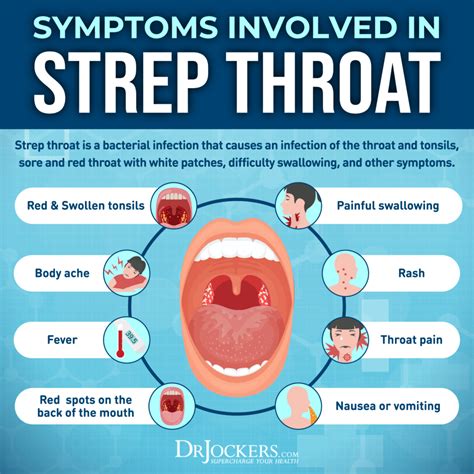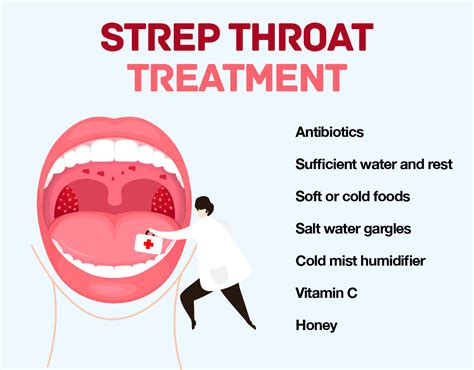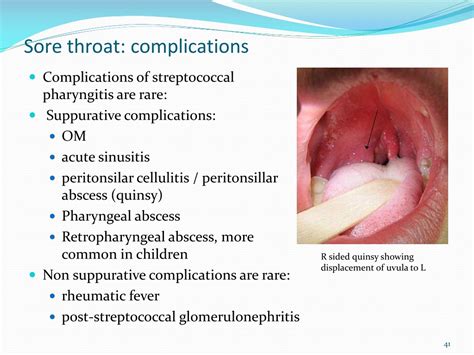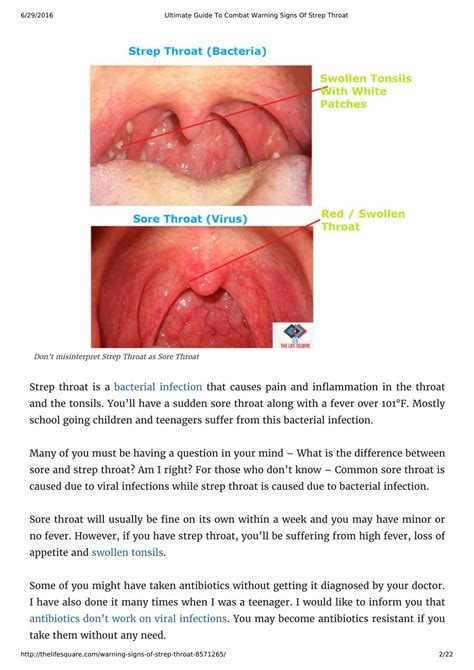Intro
Identify Strep Throat Symptoms, including sore throat, fever, and swollen tonsils, and learn about diagnosis, treatment, and prevention of this bacterial infection, also known as Streptococcal Pharyngitis.
Strep throat, also known as streptococcal pharyngitis, is a highly contagious infection that affects the throat and tonsils. It is caused by the group A Streptococcus bacteria and can spread through direct contact with an infected person, contaminated food and water, or by touching surfaces that have come into contact with the bacteria. Strep throat is a common illness that affects people of all ages, but it is most prevalent among children and adolescents. The symptoms of strep throat can vary from person to person, but they often include a sore throat, fever, and swollen lymph nodes.
The importance of recognizing the symptoms of strep throat cannot be overstated. If left untreated, strep throat can lead to serious complications, such as kidney inflammation, rheumatic fever, and abscesses. Moreover, strep throat can be contagious for up to 24 hours before symptoms appear, making it essential to take preventive measures to avoid spreading the infection. In this article, we will delve into the world of strep throat, exploring its symptoms, causes, diagnosis, treatment, and prevention. Whether you are a parent, a healthcare professional, or simply someone interested in learning more about this common illness, this article aims to provide you with a comprehensive understanding of strep throat.
Strep throat is a significant public health concern, with millions of cases reported worldwide each year. The economic burden of strep throat is substantial, with costs associated with medical treatment, lost productivity, and absenteeism from school and work. Furthermore, the emotional toll of strep throat on individuals and families should not be underestimated. The pain, discomfort, and anxiety caused by strep throat can be debilitating, making it essential to seek medical attention promptly if symptoms persist or worsen over time. By understanding the symptoms, causes, and treatment options for strep throat, we can work together to reduce the incidence of this illness and improve the quality of life for those affected.
Causes of Strep Throat

The group A Streptococcus bacteria are highly adaptable and can survive on surfaces for extended periods. They can also be transmitted through the air when an infected person coughs or sneezes, releasing droplets that contain the bacteria. The bacteria can colonize the throat and tonsils, leading to a range of symptoms, from mild to severe. In some cases, the bacteria can also infect other parts of the body, such as the skin, lungs, and kidneys, leading to more severe complications.
Risk Factors for Strep Throat
Several risk factors increase the likelihood of developing strep throat. These include: * Age: Strep throat is most common among children and adolescents, although it can affect people of all ages. * Exposure to infected individuals: Living or working in close proximity to someone with strep throat increases the risk of transmission. * Poor hygiene: Failing to practice good hygiene, such as washing hands regularly, can increase the risk of transmission. * Weakened immune system: Individuals with weakened immune systems, such as those with chronic illnesses or taking immunosuppressive medications, are more susceptible to strep throat. * Seasonal variation: Strep throat is more common during the winter and early spring months, when people are more likely to be indoors and in close proximity to one another.Symptoms of Strep Throat

Diagnosis of Strep Throat
Diagnosing strep throat typically involves a physical examination, medical history, and laboratory tests. The healthcare provider may perform a throat swab to collect a sample of cells from the throat, which is then sent to a laboratory for testing. The rapid strep test is a common diagnostic tool that can provide results within minutes. However, this test is not always accurate, and a throat culture may be necessary to confirm the diagnosis.Treatment Options for Strep Throat

In addition to antibiotics, there are several home remedies that can help to alleviate the symptoms of strep throat. These include:
- Resting and avoiding strenuous activities
- Staying hydrated by drinking plenty of fluids
- Using a humidifier to add moisture to the air
- Gargling with salt water to reduce inflammation
- Taking over-the-counter pain relievers, such as acetaminophen or ibuprofen
Prevention of Strep Throat
Preventing strep throat involves practicing good hygiene, avoiding close contact with infected individuals, and avoiding sharing food, drinks, or utensils. It is also essential to wash hands regularly, especially after blowing your nose, coughing, or sneezing. Avoiding touching your face, especially your mouth, nose, and eyes, can also help to reduce the risk of transmission.Complications of Strep Throat

Long-Term Effects of Strep Throat
The long-term effects of strep throat can be significant, especially if the infection is left untreated or if it recurs frequently. Repeated episodes of strep throat can lead to chronic inflammation and scarring in the throat, which can cause ongoing symptoms and discomfort. In rare cases, strep throat can lead to more severe complications, such as rheumatic fever, which can have long-term effects on the heart and joints.Conclusion and Final Thoughts

We invite you to share your thoughts and experiences with strep throat in the comments section below. Have you or a loved one been affected by strep throat? What steps have you taken to prevent the spread of this infection? By sharing our knowledge and experiences, we can raise awareness and promote better health outcomes for everyone.
What are the most common symptoms of strep throat?
+The most common symptoms of strep throat include a sore throat, fever, swollen lymph nodes, white patches on the tonsils, and a red, swollen throat.
How is strep throat diagnosed?
+Strep throat is typically diagnosed through a physical examination, medical history, and laboratory tests, such as a throat swab or rapid strep test.
What are the potential complications of strep throat?
+The potential complications of strep throat include kidney inflammation, rheumatic fever, abscesses, sinusitis, and ear infections.
How can I prevent the spread of strep throat?
+To prevent the spread of strep throat, practice good hygiene, avoid close contact with infected individuals, and avoid sharing food, drinks, or utensils.
What is the typical treatment for strep throat?
+The typical treatment for strep throat involves antibiotics, such as penicillin or amoxicillin, and home remedies, such as rest, hydration, and over-the-counter pain relievers.
